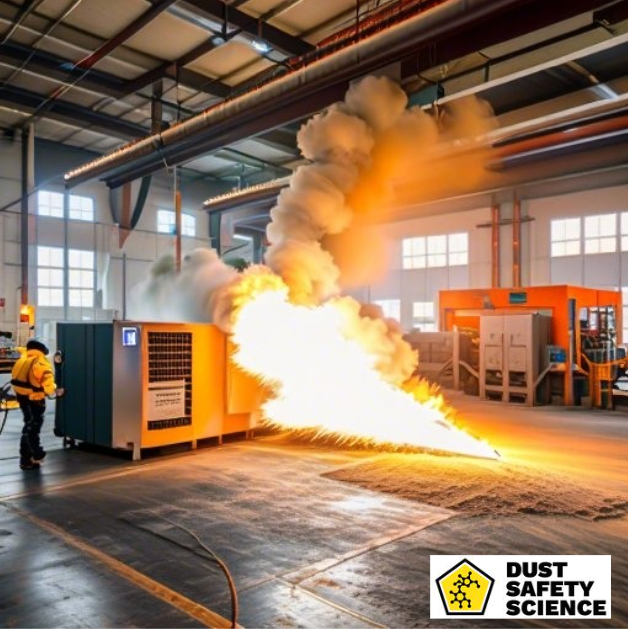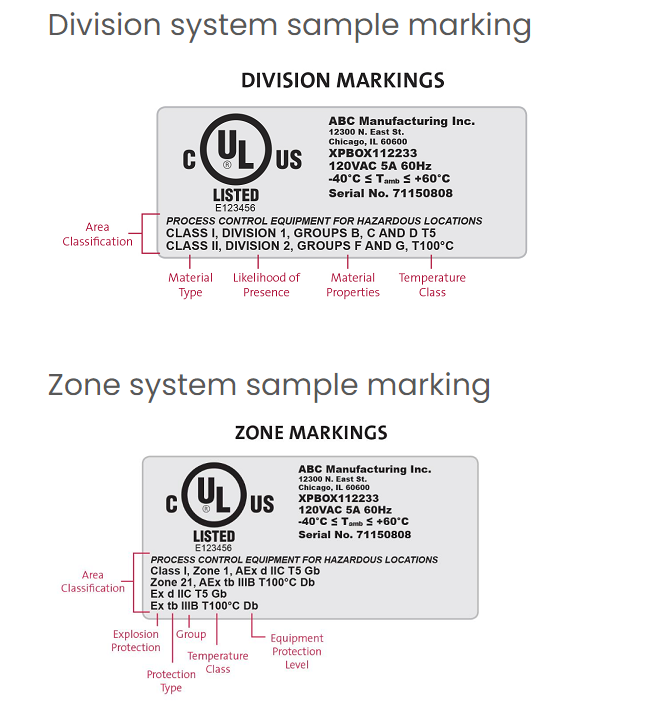Updated March 20, 2025
Authored by Dr. Chris Cloney and Jon Barrett of Dust Safety Science
Learn about different ignition sources and how to manage and prevent them from starting fires and explosions.

The Critical Role of Ignition Sources in Industrial Safety
Safety is paramount in industrial settings. Ignition sources and electrical devices, whether obvious or hidden, such as static electricity, play a crucial role in workplace safety. These sources ignite flammable materials and increase surface temperature, leading to fires, explosions, and catastrophic accidents. Performing a risk assessment, understanding, and managing ignition sources are vital to prevent such incidents and protect lives and property.
Key Takeaways:
- Ignition sources in industrial settings can be mechanical, thermal, electrical, or chemical.
- The presence of ignition sources could include hot surfaces, welding operations, electrical equipment, or friction from moving machinery.
- Effective management and prevention of ignition sources keep everyone safe in industrial workplaces. These sources should be identified and assessed to reduce the possibility of fire and explosions that could endanger workers.
Unlock expert insights to keep your workplace safe—ask us how.
TABLE OF CONTENTS
The Critical Role of Ignition Sources in Industrial Safety
What Constitutes an Ignition Source?
Importance of Managing Ignition Sources to Prevent Dust Explosions
Definition and Types of Ignition Sources
Examples of Each Type of Ignition Sources in Industrial Settings
The Science of Ignition and Combustion
How Ignition Sources Interact with Combustible Materials
Methods for Identifying Potential Ignition Sources in the Workplace
Risk Assessment Strategies
Dust Hazard Analysis for Identifying Ignition Sources
Design and Maintenance Practices for Ignition Sources
Specific Measures for Different Types of Ignition Sources
Importance of Regular Inspections and Maintenance Routines
Technological Solutions for Ignition Control
Benefits of Integrating Safety Technologies
Role of Training in Preventing Ignition-Related Incidents
What Constitutes an Ignition Source?

An ignition source is any element or condition that can ignite a combustible material. This includes electrical sparks, electrical equipment, electrical devices, hot surfaces, static electricity, mechanical sparks, and chemical reactions. Ignition sources can be accidental, like a short circuit, or natural, like static electricity. According to Underwriters Laboratory, they perform several tests to certify wiring and ignition sources:
Electric Ignition Source:
This method is used to determine the flammability of end products using a glow wire loop. The test is suitable for end products that are exposed to an electrically heated source.
Electric ignition source GWEPT – Glow Wire End Product Testing:
This method is used to determine the flammability of end products using a glow wire loop. The test is suitable for end products that are exposed to an electrically heated source. Standards for Electric ignition source GWEPT: UL 746A, IEC 60695-2-11, or equivalent standards
Electric ignition source GWFI – Glow Wire Flammability Testing:
This method is used to determine the glow wire flammability index of a test specimen by means of a glow wire loop. Standards for Electric ignition source: GWFIUL 746A, IEC 60695-2-12, or equivalent standards
Electric ignition source GWIT – Glow Wire Ignition Temperature:
This method is used to determine the glow wire ignition temperature of a test specimen by means of a glow wire loop. Standards for Electric ignition source GWIT: UL 746A, IEC 60695-2-13, or equivalent standards
Electric ignition source HWI – Hot Wire Ignition:
This method is used to determine the ignition times of electrical insulation materials. The ignition time is the time which is required to ignite a wire-wound test specimen. This time serves as the assessment criterion for assigning the material to a Performance Level Class (PLC). Standards for Electric ignition source HWI: UL 746A, ASTM D3874, or equivalent standards
In addition, UL is one of the top issuers of global ATEX and IECEx certifications,
ATEX Certification for the European Union:
Hazardous locations and explosion-protected equipment intended for installation in the European Union must comply with the ATEX Directive 2014/34/EU, which replaced the former ATEX Directive 94/9/EC.
Importance of Managing Ignition Sources to Prevent Dust Explosions
Effectively managing ignition sources and electrical equipment is a key aspect of industrial safety. Proper identification, assessment, and control of these sources can significantly reduce the risk of fires and explosions, ensuring a safer working environment. Combustible dust refers to finely divided solid particles that are prone to ignition when suspended in the air. These particles can originate from various materials and industries, including agriculture, manufacturing, and chemical processing.
Dust qualifies as combustible when it possesses specific characteristics that make it prone to ignition and combustion when suspended in the air. These key attributes include particle size, concentration, and chemical composition. Fine particles, often smaller than 420 microns, are more likely to ignite due to their increased surface area. Additionally, a dust cloud must reach a certain concentration level in the atmosphere to become combustible.
At the Didion Milling Dust Explosion, a catastrophic dust explosion caused by ignition sources occurred. Numerous Occupational Safety and Health Administration (OSHA) Citations and Penalties were issued.
An FM Global report, “Dust qualifies as combustible,” was published around 2012. The scope of this report encompasses three categories of ignition sources: those inherent in processes or equipment, those arising from equipment malfunction, inadequate design, or lack of essential protective systems, and those introduced by human actions.
Definition and Types of Ignition Sources
Electrical Ignition Sources:
Electrical ignition sources include electrical devices, faulty wiring, overloaded circuits, and static electricity. These sources of ignition can create sparks that ignite flammable materials. For example, a damaged wire in an industrial machine, an electrical equipment panel, or electrical devices can spark and ignite nearby dust or gas.
Thermal Ignition Sources:
Thermal sources involve heat generated by hot surfaces, friction, and radiant heat. Machinery or electrical devices with hot surfaces, increased surface temperature, or processes generating high temperatures can ignite combustible materials. An example is a furnace that reaches high temperatures and ignites nearby flammable substances.
Mechanical Ignition Sources:
Mechanical ignition sources include sparks from metal impacts, grinding, and friction. These sparks can easily ignite explosive dust or gases in industrial settings. For instance, welding operations often produce sparks that can ignite surrounding materials.
Chemical Ignition Sources:
Chemical sources involve spontaneous combustion and reactive materials. Certain chemicals can react violently, with exothermic reactions, when exposed to each other or specific conditions, leading to fires or explosions. For example, mixing incompatible chemicals in a lab can result in a spontaneous fire.
Examples of Each Type of Ignition Sources in Industrial Settings
- Electrical: A short circuit in an electrical equipment panel or device can cause a fire and electrical arcing. Static electricity can also be an electrical ignition source.
- Thermal: Overheated machinery igniting nearby materials and materials such as Lithium Ion batteries for energy storage systems.
- Mechanical: Sparks from welding igniting flammable gases can be sources of ignition
- Chemical: Improper storage of reactive chemicals as sources of ignition, leading to exothermic reactions and spontaneous combustion
Ensure a safer work environment—enroll in our comprehensive safety training today!
The Science of Ignition and Combustion
Combustion is a chemical process that requires three elements: heat, fuel, and oxygen, known as the fire triangle. Without one of these elements, combustion cannot occur.
- Heat: Provides the energy needed for ignition.
- Fuel: A combustible material that sustains the fire.
- Oxygen: Supports the chemical reactions of combustion.
How Ignition Sources Interact with Combustible Materials
Ignition sources provide the necessary heat to reach the ignition temperature of a combustible material. Once the material reaches this temperature, it reacts with oxygen in the air, leading to combustion. The presence of sufficient fuel and oxygen allows the fire to sustain and spread. Occupational Safety and Health Administration provides Electrical Hazardous (classified) locations, This section covers the requirements for electric equipment and wiring in locations that are classified depending on the properties of the flammable vapors, liquids or gases, or dust or fibers that may be present therein and the likelihood that a flammable or combustible concentration or quantity is present.
Methods for Identifying Potential Ignition Sources in the Workplace
Identifying potential ignition sources involves thorough inspections and hazard assessments. Regularly check electrical equipment, electrical systems, and storage areas for signs of potential sources of ignition. Use tools like thermal imaging cameras to detect hotspots and electrical faults in electrical equipment.
Risk Assessment Strategies
Risk assessments evaluate the likelihood and severity of potential ignition incidents and sources of ignition. They use a combination of qualitative and quantitative methods. Factors like the presence of flammable materials, static electricity, the condition of electrical equipment, and historical incident data are considered.
Dust Hazard Analysis for Identifying Ignition Sources
A Dust Hazard Analysis (DHA) is a systematic review that identifies and evaluates the potential fire, flash fire, or explosion hazards associated with the presence of one or more combustible particulate solids in a process or facility (NFPA 652-19).
The goal of a Dust Hazard Analysis is to identify fire, flash-fire, and explosion hazards that pose a risk to people and property. Each process or area reviewed will fall into one of five categories:
- Not a Hazard: In instances where the Dust Hazard Analysis determines that no hazard is present, no further investigation or precautionary measures are necessary. This classification provides peace of mind, indicating that the process or area under scrutiny is safe from fire, flash-fire, or explosion risks.
- Could be Hazardous: Additional testing and information are required to determine whether a hazardous condition exists or not. If the analysis identifies the potential for hazards but lacks sufficient information or testing data to confirm their existence conclusively, additional investigations and data collection become imperative. This stage serves as a critical step towards ensuring safety by striving to either confirm or rule out hazardous conditions.
- Fire Hazard: Within the scope of a DHA, the recognition of a fire hazard signifies the potential for combustible materials to ignite and sustain a fire. This broader category encompasses various scenarios where the ignition of flammable substances poses a threat to safety and property.
- Flash Fire Hazard: Expanding further, a DHA may reveal the presence of flash fire hazards. Flash fires are rapid, intense fires that occur when flammable gasses, vapors, or dust particles ignite suddenly. Identifying flash fire hazards is crucial for implementing preventive measures and ensuring the safety of personnel and facilities.
Explosion Hazard: Among the most severe outcomes, a DHA can uncover the risk of explosions. Explosions result from the rapid release of energy and can have devastating consequences. Identifying explosion hazards in a DHA is paramount to establishing comprehensive safety measures, including the containment of explosive potential and the protection of individuals and assets.
Design and Maintenance Practices for Ignition Sources
Implement design and maintenance practices to control ignition sources. Design electrical equipment with safety features, such as automatic shut-offs and thermal insulation. Static electricity safety measures must be designed to eliminate all static charges in a facility. Conducting material should be earthed by the use of bonding. Regularly maintain and inspect equipment to ensure it operates safely from sources of ignition.
Specific Measures for Different Types of Ignition Sources
- Electrical: Use explosion-proof electrical fixtures in hazardous areas.
- Thermal: Insulate hot surfaces and implement temperature controls
- Mechanical: Implement spark arrestors in welding operations
- Chemical: Store reactive chemicals separately and in appropriate containers.
Stay ahead of the regulations—sign up for expert-led combustible dust safety training.
Importance of Regular Inspections and Maintenance Routines
Regular inspections and maintenance are critical to identify and address potential ignition sources before they lead to incidents. Implement a schedule for routine checks and promptly address any identified hazards, with sources of ignition.
Technological Solutions for Ignition Control
Modern technology offers advanced tools to monitor and control ignition sources. These include fire detection systems, gas detectors, and automated shutdown systems. Integrating these technologies into industrial operations enhances safety by providing early warning and automatic response to potential ignition events.
Benefits of Integrating Safety Technologies
Integrating safety technologies improves incident response times and reduces human error. Automated systems can detect and mitigate hazards faster than manual methods, significantly reducing the risk of fires and explosions.
Role of Training in Preventing Ignition-Related Incidents
Proper training ensures that employees understand the risks associated with ignition sources and know how to manage them. Regular training sessions on fire safety, equipment handling, and emergency response are essential.
Conclusion
Understanding and managing ignition sources is crucial for industrial safety. Effective identification, assessment, and control of these sources can prevent fires, explosions, and other serious incidents, ensuring a safer working environment.
In industrial settings, sources of ignition play a critical role in the prevention of dust explosions. Common heat sources include hot surfaces, electrical circuits, and mechanical equipment, which can reach dangerous surface temperatures. When equipment is not properly maintained, exposed wiring can create electrical sparks, igniting flammable dust or combustible materials. Additionally, open flames or chemical reactions can further elevate risks by contributing sufficient energy to ignite explosive atmospheres. Understanding the fire triangle, which consists of a fuel source, oxygen, and an ignition source, helps identify ways to mitigate these hazards. Without one of these elements of the fire triangle, combustion cannot occur. A risk assessment should always be conducted to ensure proper storage of flammable gases and flammable liquids, which may otherwise react with heat sources or electrical sparks.
Another key consideration is the minimum ignition temperature of dust clouds, as sources of ignition, like hot surfaces and hot gases, can exceed these thresholds. In explosive atmospheres, even a small chemical reaction or exothermic reaction can result in shock waves or spontaneous ignition. During normal operation, mechanical equipment may produce heat, or electrical circuits may generate electrical sparks, both of which can trigger dust explosions in sensitive areas. By controlling heat sources and ensuring proper storage of combustible materials, industries can minimize the risk of open flames, chemical reactions, and sources of ignition in their surrounding environment.
Continuous improvement in safety practices is essential. To keep up with evolving risks, safety protocols should be regularly updated, new technologies invested in, and ongoing training provided. A proactive approach to managing ignition sources can significantly enhance workplace safety.
Ready to tackle combustible dust risks? Reach out to us for guidance!
About Dust Safety Science
Dr. Chris Cloney, of Dust Safety Science, provides additional Ignition Sources information, with a Podcast. Click on the latest Podcast Link: Safety Share – Dust Explosion Damage.

Resources:
Visit Dust Safety Science (Global Incident Tracking)
Visit Dust Safety Academy (Resources, Training, and Events)
Visit Dust Safety Professionals (Need Help? Get Support Today!)
Visit Dust Safety Journal for the Dust Safety Science Monthly Journal
Subscribe to our Dust Safety Science Newsletter at Dust Safety Science Newsletter
Visit the Dust Safety Science blog for written articles on combustible dust safety including the latest research, expert opinions, and state-of-the-art in fire and explosion protection.
